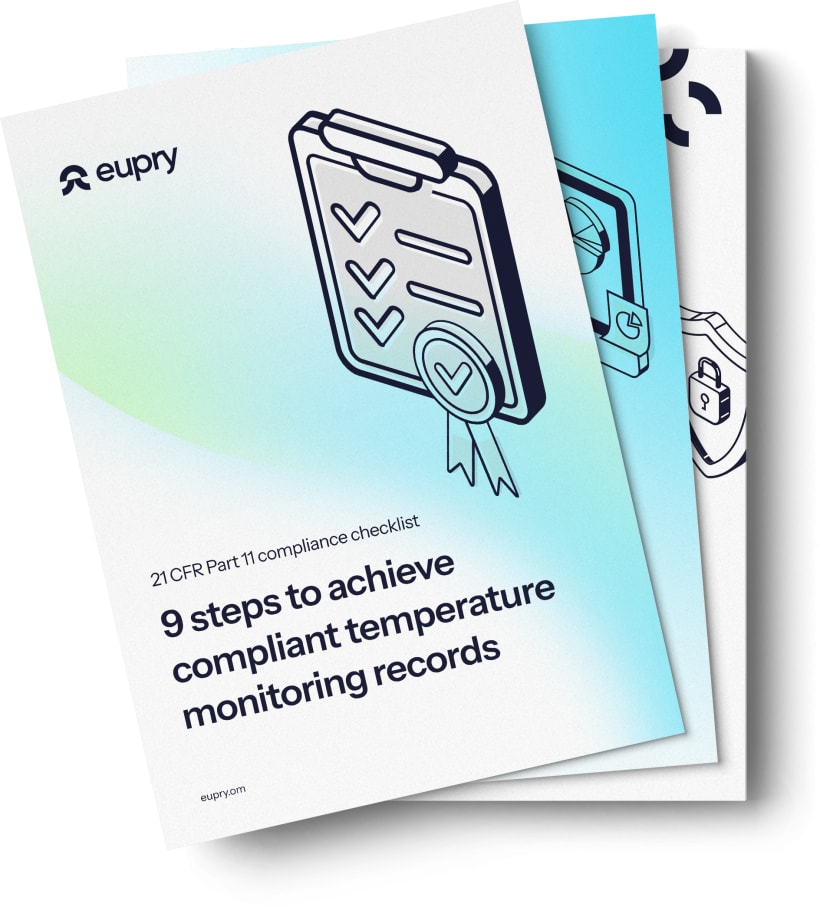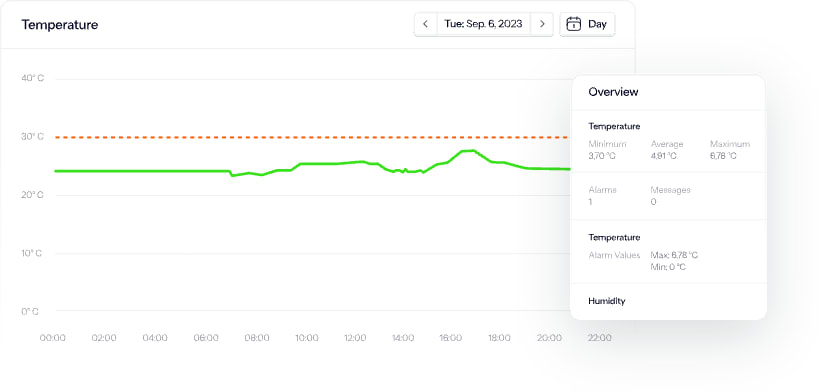
21 CFR Part 11 compliant temperature monitoring systems: What to look for?
Jakob Konradsen

Estimated reading time: 4 minutes
You can make your compliance efforts simpler and more efficient by choosing an FDA 21 CFR Part 11-ready system for temperature and humidity monitoring.
Complying with 21 CFR Part 11 requirements lets you secure the integrity of your digital records, enable efficient data management, and heighten compliance – and the (proper) use of a monitoring system aligned to Part 11 rules can make living up to the standard quick and simple.
But what should you look for in a 21 CFR Part 11 compliant monitoring system?
We will dive into the definition, what to consider when choosing, and give you an example of a 21 CFR Part 11 ready monitoring solution.
Also read: Understanding key regulations and standards of temperature compliance

9 steps to achieve FDA 21 CFR Part 11-compliant temperature records
Ensure compliance of your temperature records with a “21 CFR part 11 compliance checklist”
Why no system in the world can guarantee your compliance
First things first: We should actually talk about “21 CFR Part 11 ready” instead of “21 CFR Part 11 compliant” systems.
Why?
Because even the best system in the world can’t ensure your Part 11 compliance (sorry).
An example: A system might have unique users and authentication, but the use of it still won’t be compliant if you and your team simply share the same login details.
No matter how safe your car is, you still have to drive it responsibly.
But what a system can do is make compliance simpler. Let’s dive into how.
Also read: "9 questions: Ensuring FDA 21 CFR Part 11 compliant temperature monitoring in pharma"

What should a 21 CFR Part 11 ready monitoring system be able to do?
There are two main elements to consider when assessing if a system will make 21 CFR Part 11 compliance, for one, possible, and for two, easy.
We can call them:
- The compliance checkmarks
- The ease of (compliant) use
1. The compliance checkmarks
Of course, there are some boxes that have to be checked. To live up to FDA 21 CFR Part 11, your temperature monitoring system and devices should (of course) be validated and calibrated to ensure accurate measurements.
- Validation involves the testing and documentation of your monitoring system’s performance to show that it consistently creates reliable results and verify that the system functions within specified parameters and meets the intended requirements.
- Calibration involves comparing the readings of a temperature monitoring sensor to the relevant standard to determine the accuracy of the device and maintain the accuracy of your temperature data over time, as devices can drift from their initial calibration values due to various factors such as wear and tear, environmental conditions, or aging components.
Also read: What is calibration and why is it important?
2. The ease of (compliant) use
How do you spot if your temperature monitoring system will make it easier – or harder – to comply with 21 CFR Part 11?
The 7 things that will make 21 CFR Part 11-compliance easier
- Traceability: Does the system make it easy to trace changes to data and establish clear audit trails? For instance, does it:
- automatically include reliable time stamps when records are created and altered?
- offer the option to make the signing of data creation and changes mandatory to support the requirement of personal accountability?
- Unique users: Is it possible to create unique users for all relevant personnel?
- Permission types: Does it include different user roles with variable permissions to fit the requirement of user access control?
- Authentication mechanisms: Does the system allow for or integrate easily with reliable user authentication methods such as biometric authentication, or multi-factor authentication to verify the unique identity of the user?
- Data backups: Are there data backup mechanisms included?
- Process documentation: Is it possible to document your monitoring processes in the system?
- Training: Does the vendor offer tutorials and training in the compliant use of the monitoring system?

9 step 21 CFR Part 11 guideline
Get a step-by-step checklist to make sure your temperature compliance and monitoring are FDA 21 CFR Part 11 compliant.
Example: A monitoring solution designed to make 21 CFR Part 11-compliance simple
Lastly, an example: How Eupry’s temperature monitoring system is designed to simplify 21 CFR Part 11 compliance.
Why? Since temperature data is required under predicate rule and relied upon to make informed decisions related to product safety, a digital temperature monitoring solution falls under the scope of 21 CFR Part 11. Eupry, as a software solution, should therefore support compliance with the requirements.
How does that work in practice?
-
General validation: Validation of products and systems is a key part of delivering high-quality services and a significant part of any development process within Eupry, and a large part of the Part 11 requirements are covered in this validation of the system. Through our validation process, we document how the system is intended to be used and how it will react in all cases. This helps companies qualify the solution in relation to their own need.
-
Calibration: To keep up with the calibration requirement, the system monitors data loggers’ calibration status and automatically notifies when it is time for calibrating some or all of your data loggers (at which time, Eupry’s patented calibration technology allows you to handle calibrations in minutes).
See HOW the patented calibration technology works
- The specialized 21 CFR Part 11 module: The monitoring and validation software also has a specialized 21 CFR Part 11 module that can be activated if your organization needs to comply with the standard. The module opens up extra functionality such as automated audit reports and mandatory signing of record creation and changes.
See some of the functionality in our free solution catalog.

Eliminate regulatory risks and minimize the time you spend on monitoring by 70%
How does the automated temperature compliance solution work?
